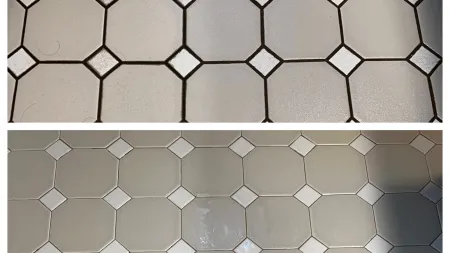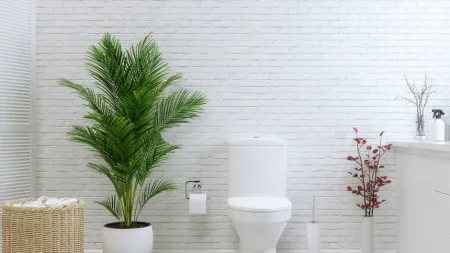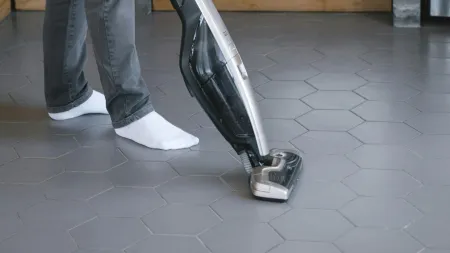Slippery Tile Floors: How to Make Tile Less Slippery
Ever ask "Why is my tile floor so slippery?" Well, water, grease, excessive floor polish or wax, mold, cooking fat, soap residue, and cleaning chemicals or floor polishes that are noncompatible with your tiles make tile floors slippery and potentially even deadly.
You can fix a slippery tile floor by:
- Using anti-slip tile coatings
- Adding foam pads to the tiled floor
- Using carpet runners or area rugs
- Correctly cleaning and properly drying the tile floor
- Installing non-slip tiles
- Installing a floating floor over the tile
We will focus on the causes of a slippery tile floor, how to make tiles not slippery, and more.
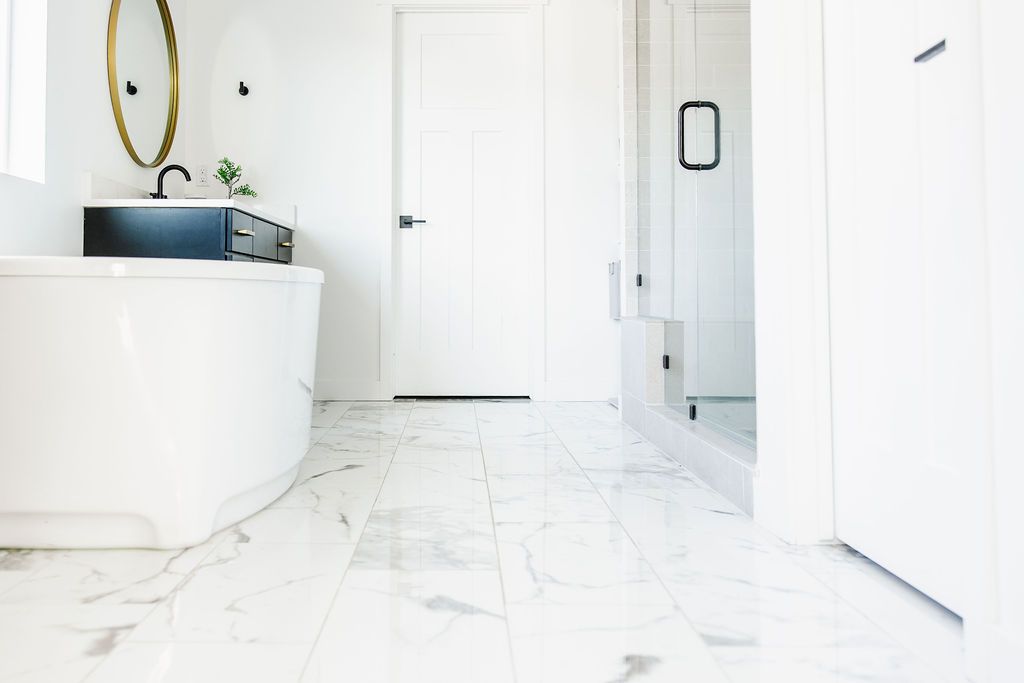
4 Major Causes of Slips and Falls on Slippery Tile Floor
Tiles have a smooth finish, which makes them slippery under certain circumstances, as noted below:
- Wet tile: Water and other liquids make tile floors slippery, making kitchen and bathroom tile more prone to slips and falls.
- Lack of traction: Smooth, polished tiles with non-slip properties cause shoes to lose grip, resulting in slips and falls.
- Dirt and dust: Dirt and dust reduce the tiles' grip and make your feet black too.
- Poor cleaning techniques: Leaving soap/detergent residue on tile floors makes them slippery and can cause your shoes to squeak on the tile. Use the recommended cleaning products based on your tile type to avoid making it slick. Don't use too much cleaning solution. It could result in too much soap foam that is difficult to rinse. Mildew and mold make tiles slippery, especially in bathrooms. Clean bathroom tile floors often.
How to Fix a Slippery Tile Floor
The Consumer Product Safety Commission approximates that more than two million fall injuries in the U.S. occur annually due to floors and flooring materials. The National Floor Safety Institute (NFSI) approximates that more than one million hospital visits annually are due to slips and falls.
The DCOF (Dynamic Coefficient of Friction Value) sets the minimum standard for the interior tile floor as>.42 DCOF.
Choose tile floors that meet or exceed this minimum standard. Save a life by fixing a slippery tile flooring!
Here's how to fix slippery tile.
1. Using Anti-Slip Tile Coatings
The market offers anti-slip tile coatings for tile floors. These include deck grip, polish grip, and stone grip non-slip coatings; they increase traction.
- Stone grip non-slip tile treatment: Use stone grip non-slip tile treatment to increase traction on your tile floor. The coating doesn't change the tile's appearance. Apply the treatment using a sprayer, stone grip applicator, or microfiber T-mop.
- Polish Grip: It's resistant to stains and spills and provides better traction. Polish grip is applicable on indoor and outdoor tiles.
- Deck grip anti-slip tile coating: Improves traction on indoor and outdoor tile floors such as balconies, pool decks, and pantries. This coating is beautiful, semi-glossy, and friendly to your feet.
2. Installing a Floating Floor Over the Tile
Floating floors can effectively mitigate slips and falls. You can install laminate or real wood floating floors depending on your taste and budget. Choose this option if you don't mind losing your slippery tile floor, as installing a floating floor could damage the tile floor underneath. And, remember that hardwood floors can be slippery too.
Don't install the floating floor over a damaged or worn-out tile, as it could cause the floating floor to move out of place.
Floating floors are difficult to install; hire a professional. An expert should assess your tile floor type and condition and advise on the best wood type and installation method.
3. Adding Foam Pads to Tiled Floor
Foam flooring is ideal for fixing slippery tiled floors in playrooms, workshops, gyms, and mudrooms. Foam pads are durable, soft, and moisture-resistant, and they are easy to clean and install.
If you install them in a high-traffic area, you may have to change them often, making them an on-going expensive option for some.
4. Installing Non-Slip Tiles
Installing non-slip tiles is rewarding because you'll never worry about anyone falling and getting hurt, especially the elderly and children. It's an expensive and laborious option.
5. Using Carpet Runners or Area Rugs
Using carpet runners or area rugs is the quickest way to fix slippery tile floors. Buy carpet runners or area rugs with non-slip backing to keep them in place. Consider the type of tile you have when buying the runners or rugs with non-slip backing; some backing materials damage the floor.
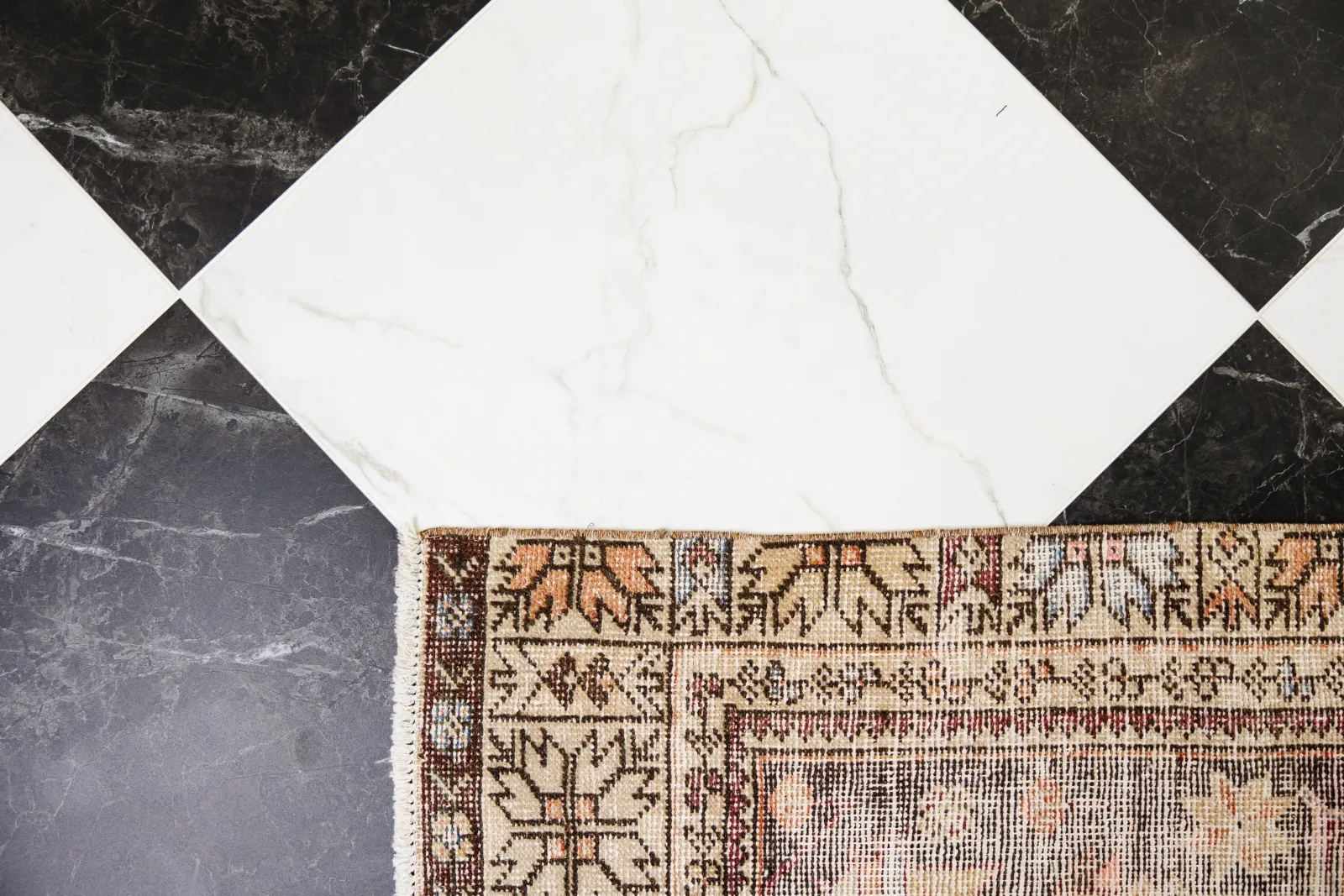
Carpet runners or area rugs may not entirely fix a slippery floor because they don't cover the entire house. Use them in high-traffic and high-risk areas such as hallways, large open rooms, sinks, the bottom of stairs, and entryways.
Anti-slip mats offer better traction and are ideal for areas with high moisture, such as restrooms and kitchen floors. Plastic matting is also good as it holds firmly to the slippery tile floor.
How to Make Floor Tiles Less Slippery
If your budget doesn't allow you to install a floating floor or non-slippery tiles, make your floor less slippery. Here's how to make tiles less slippery.
1. Keep Your Floor Clean and Dry
Tiles become slippery when wet. Always dry your floor using a dry mop or microfiber cloth after washing. Place a 'wet floor' sign so everyone is cautious while walking if it's a high-traffic floor. Dust and debris can also cause slips and falls on some tile floors. To ensure your floor is always clean, keep up with your cleaning schedule and adjust as needed.
2. Good Drainage
Proper drainage is key to lessening slips and falls, especially in wetrooms and bathrooms. Poor drainage slows the draining system, allowing water to sit on the tile floor. Mold and grout rot also thrive on floors with poor drainage. Good drainage keeps your floor dry and safe.
Home Remedy for Slippery Tiles
Borax, vinegar, baking soda, hydrogen peroxide, salt, and other ingredients in your bathroom cabinet or pantry are cheap slippery tile solutions. Using and applying them correctly makes them safer and more effective than some commercial products. They won't discolor or damage your tile floor.
1. Baking Soda and Vinegar
Sprinkle a generous amount of baking soda on the slippery floor and pour vinegar over the top. The mixture will fizz and bubble, lifting dirt and grime from the tiles. Let the mixture sit for a few minutes, scrub the floor using a soft brush (or recommended brush based on the type of tile you have), and then rinse with plain water.
2. Salt
Salt effectively removes mildew, ice, and mold from tile floors. Rub the affected area with a damp cloth and apply salt. Let it sit overnight. Scrub with a soft brush the next day to remove mold and mildew, then rinse. Consult an expert before using salt, as it could damage some tiles.
3. Dish Soap
Kitchen and garage tile floors are more prone to grease and oils. Add several drops of dish soap to warm water and use the solution to clean the floor to remove grease and oils. Rinse really well with clean water and dry with a dry mop, towel, or microfiber cloth.
4. Vinegar
Most slips and falls result from grease and soap residue on the floor. Vinegar, being acidic, removes these residues and improves traction, making the floor non-slip.
Mix 1 cup of vinegar with 2 cups of water in a cleaning bucket. Deep a mop into the solution and use it to clean the floor.
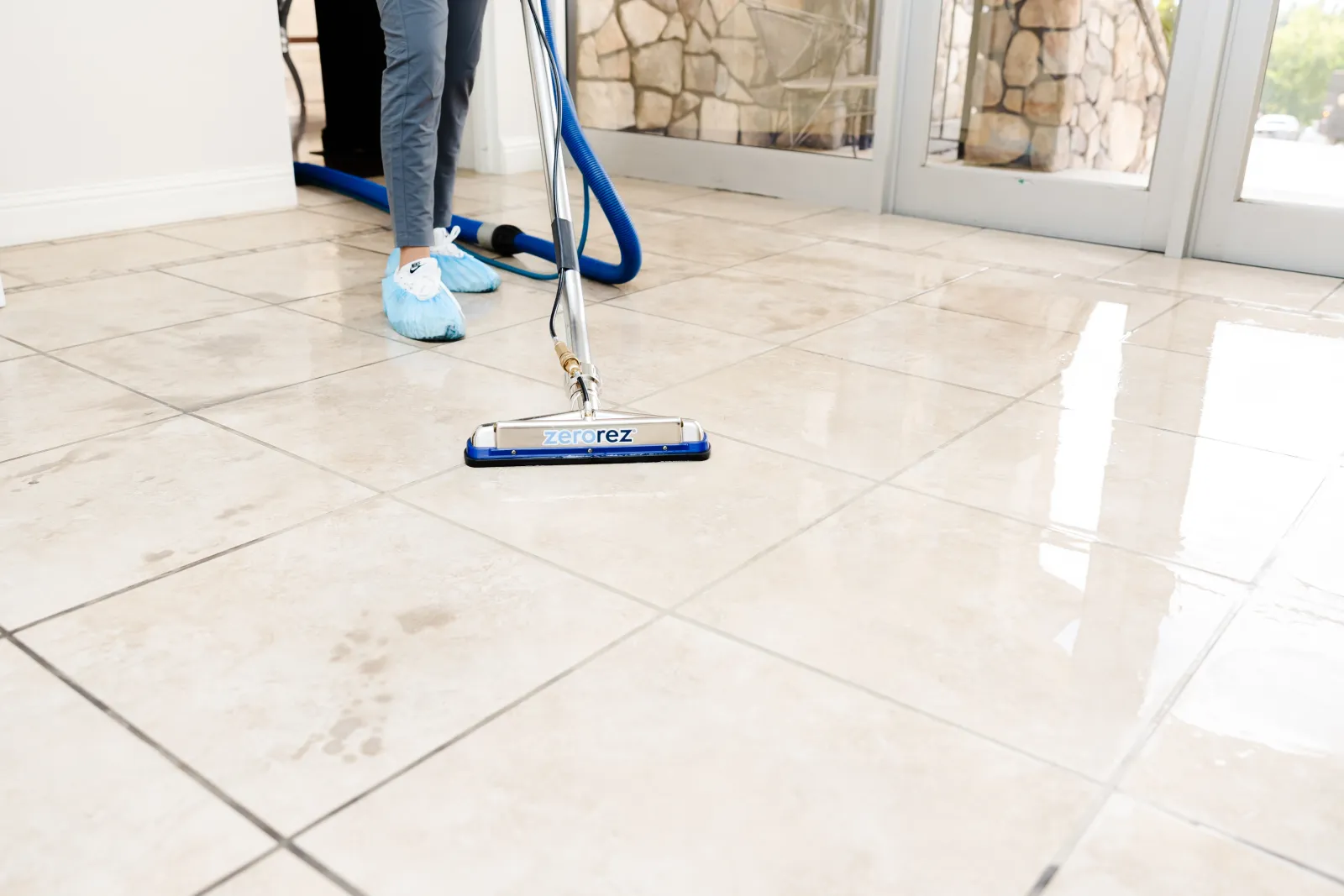
What Makes Tile Floor Slippery After Cleaning?
Tile floors become slippery after mopping due to improper drying or rinsing. After cleaning, moisture, soap, wax, talcum powder, and grease residues make the floor slippery.
Thoroughly rinse your tile floor with clean water to remove washing detergents and chemical residues, which residues make tile and grout sticky or tacky after mopping.
Thoroughly dry tile floors because water and other liquids make them slippery.
How to Fix Slippery Outdoor Tile
Since most tiles are smooth, moisture lowers their traction. Snow, rain, and melting ice will make your outdoor tiles slippery. Gritty traction strips, rugs and mats, and slip coatings can fix slippery outdoor tiles in walkways, patios, stairways, entrances, and other high-risk areas.
- Anti-Slip Coatings: Apply anti-slip coatings on outdoor tiles to improve traction by creating a textured surface. Seek advice from a professional on the best coating option for your floor type.
- Gritty Traction Strips: To improve grip on outdoor tiles, apply gritty traction strips made of abrasive material. Most abrasive, gritty traction strops are made of silicon carbide or aluminum oxide. The abrasive stops the strips from moving, providing better grip, especially on stairs and around pool decks.
- Outdoor Rugs and Mats: Place outdoor mats and rugs with non-slip backing in high-traffic and high-risk areas. The non-slip backing keeps them in place, maximizing safety.
How to Make Tile Stairs Not Slippery
Rain, humidity, and snow cause tiles to accumulate moisture, making them highly slippery. Highly smooth and polished tile stairs are also very slippery. Using carpets, anti-slip treads and nosing, and anti-slip sprays and coatings helps make tile stairs non-slippery.
1. Anti-Slip Treads and Nosing
Nosing and treads make slippery tiles safer to walk on due to fewer slips and falls. Based on their material, nosings and treads can maximize traction to eliminate injuries or deaths related to slippery stair falls. You can install them in homes or commercial tiles to prevent liability risk due to dangerous stairs.
2. Carpets
Properly installed carpets on stairs offer maximum protection against slips and falls. They're warmer than cold tiles and offer better grip than tiles.
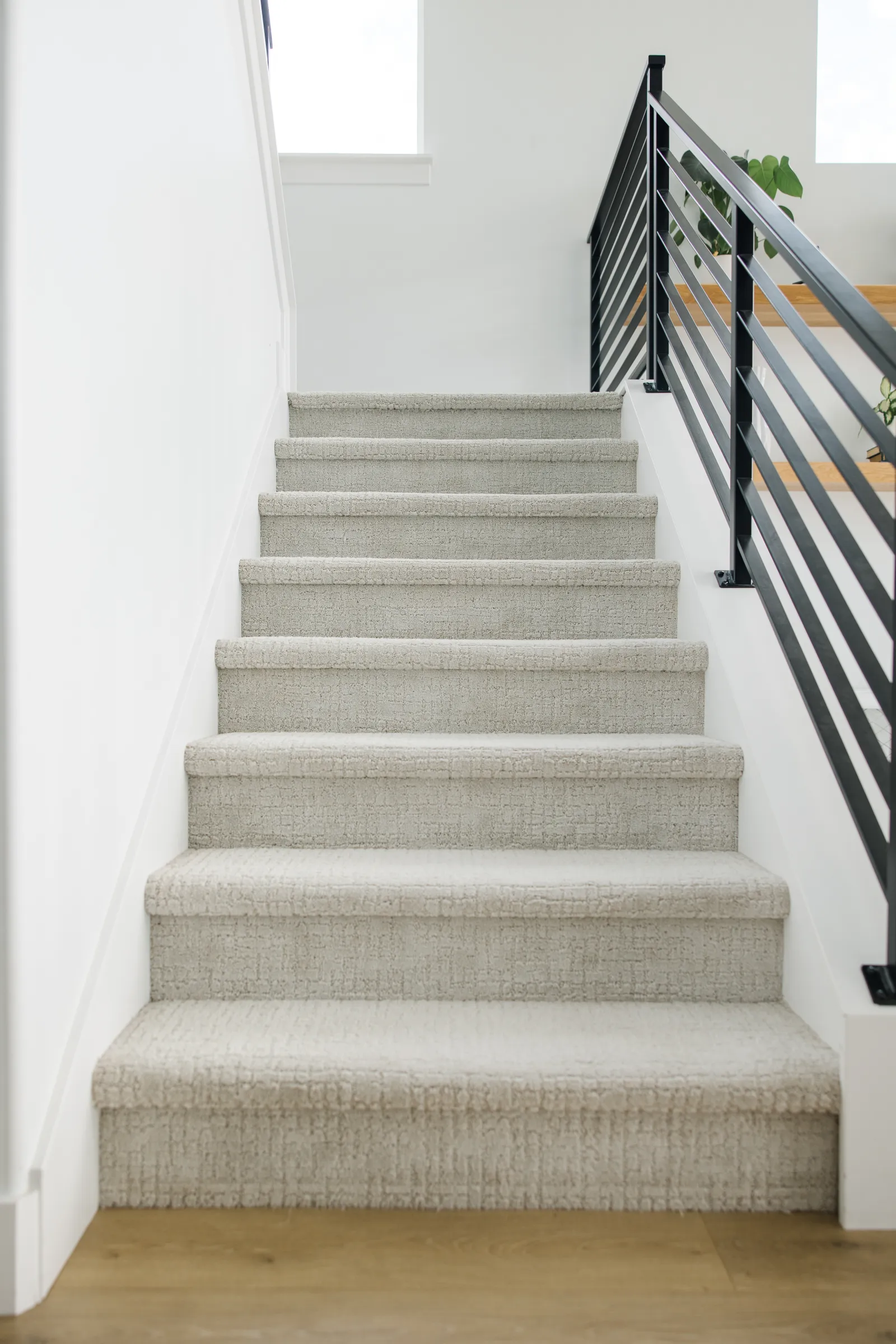
3. Anti-Slip Sprays and Coatings
Anti-slip coatings, such as Deck Grip, increase traction and lower the slipperiness of stairs. After application, wait at least 24 hours for the coating to dry for better traction before walking on the tiles.
Re-apply tile coating on the stairs after several years or as needed based on the home foot traffic.
FAQs
Is Polished Tile Too Slippery for Bathroom?
The polished tile is too slippery for the bathroom. It becomes more slippery when wet, so it's unsafe for bathrooms or other wet areas.
A good remedy for slippery bathroom tiles is keeping them clean and dry, using anti-slip mats and rugs, applying anti-slip treatments, wearing shoes with good traction when showering, and installing heavy-duty stainless metal bath handle grips.
You can also replace slippery bathroom tiles with matte or textured tiles. Always check the coefficient of friction (CoF) of tiles before buying. Most tile manufacturers publish CoF to inform buyers how slippery a certain tile is.
Is Porcelain Tile Slippery?
Depending on the texture and finishing, porcelain can be slippery or resistant to slips. The degree of porcelain tile quality varies; some are very smooth, and others are highly resistant to slips and fall.
Depending on the production and quality of your porcelain tiles, you can install them outdoors, in bathrooms, and high-foot-traffic or low-foot-traffic areas. Textured (unpolished) Porcelain tiles and those with a matte finish are highly resistant to falls and slips, making them suitable for bathrooms, laundry rooms, mudrooms, and other wet areas. T
Are porcelain tiles slippery when wet?
Yes, porcelain becomes slippery when wet, so be careful when cleaning porcelain tile floors.
Is Polished Porcelain Tile Slippery?
Polished porcelain tile is more slippery than non-polished one, especially when wet. Don't use it in bathrooms or, other wet areas or public places, as it could cause slip-related injuries or even death. It may also be worth considering ceramic tile vs porcelain tile in terms of their safety.
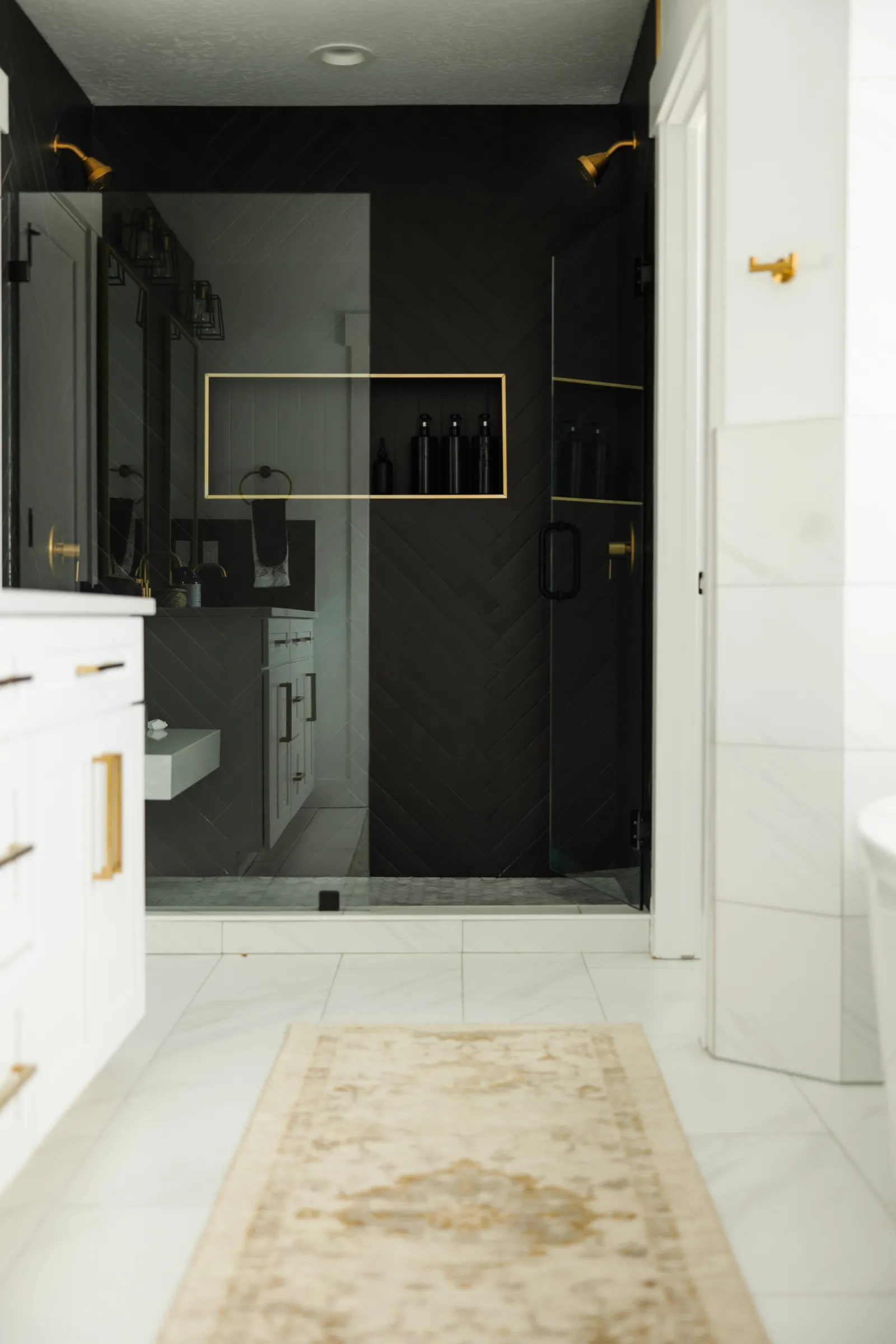
Is Marble Tile Slippery?
The slipperiness of marble tiles varies based on their texture and finish; they can be polished, brushed, tumbled, or honed. Based on their quality, marble tiles can be slippery or not.
Polished marble, for example, is smooth, making it prone to falls and slips. Brushed, tumbled, and honed marble tiles have a matte finish and have better traction because they're rougher. Brushed marble tiles are brushed with a steel comb, adding extra texture to make them non-slip.
Marble tiles have a natural finish and rougher imperfections, providing good traction. Honed-finish marble tiles are more slippery than natural ones because they have a smooth, matte, non-polished finish.
The finish of tumbled marble tile is textured and rough, providing good traction. Polished marble tile has a smooth, slippery, shiny, mirror-like finish. Due to their slippery finish, polished marble tiles are unsuitable for bathrooms and wet areas.
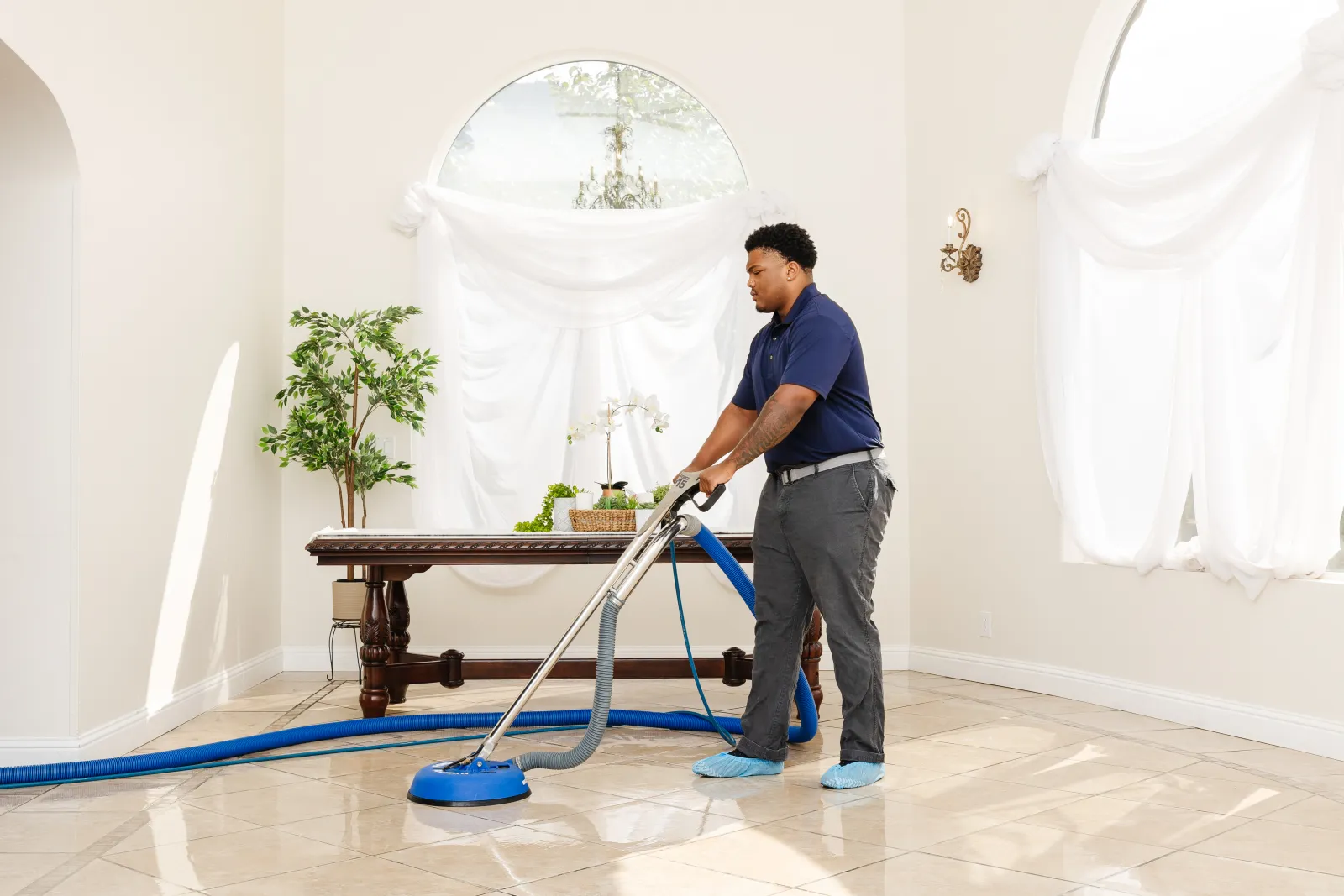
What's the Best Way to Clean Tile Floors?
Let's Help Fix the Problem! The wrong choice of cleaning chemicals is one of the major causes of a slippery tiled floor. Zerorez® wants to help you stay safe!
We will inspect your tile floors and the soil level to determine the best cleaning solution for professional tile and grout cleaning. Our proprietary Zr™ Water and cleaning products do not make tile floors slippery after they dry, mostly because it's Residue Free®!
Do you want to experience the uniqueness and professionalism of the Zerorez team? Call us or schedule an appointment today.
